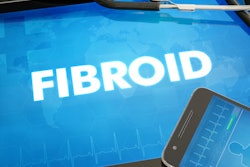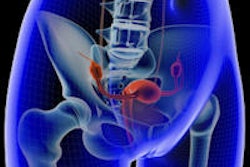MRI exams with a diffusion-weighted imaging (DWI) protocol can serve as an index to measure changes after uterine artery embolization, as well as predict volume reduction whereas before only contrast-enhanced MRI was used, researchers report in the British Journal of Radiology (16 August 2012).
Uterine fibroids are a common tumor for women, resulting in pain, menorrhagia, and impaired fertility. Uterine artery embolization is a minimally invasive technique for fibroid patients who wish to avoid surgery and preserve their fertility. As a part of treatment planning and follow-up, contrast-enhanced MRI exams are routinely used to evaluate size, location, number, and vascularity of the fibroids, and also exclude other pelvic pathology.
DWI is an MRI protocol that characterizes the motion of water within different tissues within the body. By using b-values, the apparent diffusion coefficient (ADC) may be calculated, which will determine the level of diffusion associated with the fibroids.
Baseline ADC of dominant fibroids shows a moderately strong correlation with subsequent volume reduction at six months following uterine artery embolization, according to lead study author Dr. Ganapathy Ananthakrishnan, from the department of interventional radiology at Gartnavel General Hospital in Glasgow, U.K., and colleagues. However, no correlation was identified between ADC values and contrast enhancement on the baseline or six-month exams.
The researchers included 15 patients in their retrospective study. DWI sequences were added to the standard fibroid MR imaging protocol in 2009. Two experienced practitioners performed uterine artery embolization, and a standard technique was employed using polyvinyl alcohol particles, embolizing both uterine arteries to complete stasis. MRI studies were obtained at baseline before embolization and at around six months after on a 1.5-tesla Signa HDxt MRI system (GE Healthcare).
Only the dominant fibroid was evaluated in each patient. Fibroid ADC (expressed in 10-3 mms-2) was calculated using b = 0 and b = 1000 DWI values. Fibroid enhancement was compared with background myometrium by measuring signal difference-to-noise ratio (SDNR). Fibroid volume was calculated using a prolate ellipse formula, the researchers wrote.
They found a significant reduction in fibroid ADC at six months (0.48; standard deviation [SD] = 0.26) as compared with baseline (1.01; SD = 0.39). No significant change was identified in six-month myometrial ADC (1.09; SD = 0.28) as compared with baseline (1.24; SD = 0.20).
The researchers also found moderately strong and significant positive correlation between baseline ADC and six-month percentage volume reduction of the fibroid. No correlation was identified between SDNR and ADC at baseline or six months (r = 0.01, p = 0.97 and r = 20.13 and p = 0.64, respectively) or SDNR and percentage volume reduction at six months (correlation r = 0.18, p = 0.51).
"This reduction in ADC suggests that cellular integrity is disrupted, causing cellular dehydration," the researchers wrote.
Histologically, it is known that fibroids are composed of densely packed smooth muscle cells with varying amount of intervening collagen. Prior to embolization, these clusters of cells with intact cell membranes result in a restricted pattern of diffusion, which decreases following infarction, they added.
"We also noted a slight reduction in the mean ADC value of the myometrium following embolization," the study authors wrote. "This was unexpected, and may reflect a degree of myometrial damage or, given the small [region of interest] for measurement (10-18 mm), a technical problem."
Because reduction of the myometrial ADC value was significantly less than the dominant fibroid, this suggests myometrial reperfusion occurs.
The moderately strong and significantly positive correlation identified between the baseline ADC values and subsequent dominant fibroid shrinkage may depend to some extent on the intrinsic histological nature of the fibroid, according to the researchers. "It has been suggested that this may relate to the degree of hyaline degeneration of fibroids, and this is a possibility, particularly since there is no way of differentiating these from nondegenerate fibroids on standard MRI sequences," they wrote.
The reason for no significant correlation between postembolization ADC values and percentage volume reduction is probably secondary to loss of the cellular architecture following embolization, which reduces ADC values, the researchers noted.
They acknowledged several study limitations, including its retrospective design and lack of power to detect true correlations between pairs of variables.
"We chose to assess only the dominant fibroid rather than the total fibroid burden," the study authors wrote. "Our ADC calculations were based only on b = 1000 values as we felt that there may be perfusion-related discrepancy at lower b-values. The signal-to-noise ratio in the b = 1000 images were adequate for ADC calculation."
The researchers cautioned that larger prospective studies are necessary to confirm whether DWI offers any useful additional benefit to standard contrast-enhanced MRI in uterine artery embolization.



















